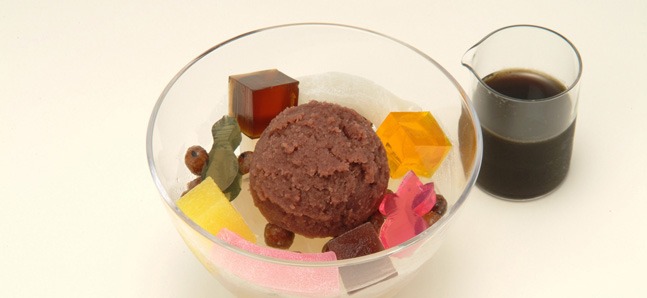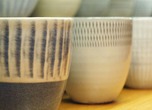
Toraya Tea Room ‘Anmitsu’
Posted: Thu Mar 25 2010
Tokyo is no doubt a foodie’s paradise, with more Michelin starred restaurants than any other city. For anyone that is entranced with food culture, traditional Japanese food with all its flavours and textures can’t be beat. One of the many gourmet foods worth trying is Tokyo’s local favourite, anmitsu – a colourful variety of Japanese dessert made from agar jelly, and usually served with an (adzuki bean paste) and fruit.
The origins of anmitsu took shape when the owner of Ginza Wakamatsu, while at a yokan (sweet jellied adzuki) shop called Funawa first combined the Asakusa-made mitsumame (a dessert made from agar jelly) with an. At the time, in 1903, Funawa was offering sweets made by pouring toumitsu (syrup) over shinko (rice flour) and aka-endou-mame (red pea). To make this concoction more appealing to adults, they would serve the confectionary in modern-looking silver bowls and garnish with flourishes of cubes of agar, anzu (sweet apricots), gyuhi (Japanese Turkish delight) and aka-endou-mame; this gave the confection an air sophistication. To add to the options, it was offered in white sugar syrup and brown sugar syrup varieties.
These various sweets, labelled mitsumame, became best sellers for the shop who, during a time when Japan was undergoing a movement that would bring it more in line with the western world, went on to open a western style café called Mitsumame Hall. This got mitsumame the rap of being a western sweet and its popularity spread like wildfire.
The next major development in the story came when this now popular dessert, mitsumame, was combined with traditional Japanese an to create anmitsu. Although this may seem obvious in retrospect, this new way of enjoying both an and mitsumame hit the jackpot; it soon outran the popularity of regular mitsumame, and went on to become known far and wide as one of Tokyo’s unique sweets.
Here are our picks for places that are noted for producing some of Tokyo’s best anmitsu. These sweet treats, with their additional an can be enjoyed sitting down in a table or whilst walking along the street. You may already know that the modern style of sushi (which was formerly known as Edomae zushi) originated in Tokyo; however, this is the perfect chance to get to know more about the next course in a Japanese meal: dessert.
For truly authentic anmitsu: Ginza Wakamatsu
Established in 1894, Ginza Wakamatsu has been in the business of sweets for well over 100 years. When the shop first opened, it sold shiruko (a sweet porridge made with boiled adzuki beans and eaten with mochi rice cake or shiratama rice-flour dumplings), however at the beginning of the Showa era, in 1930, second-generation proprietor Hanjiro Mori, combined homemade an (made from adzuki beans from Tokachi in Hokkaido, and tightly packed agar produced from tengusa algae from the Izu-shichito Islands) with mitsumame to create anmitsu – which soon became one of the shops best selling sweets. Hanjiro Mori let fellow sweet shops Tatsutano and Takemura in on his newly invented recipe and anmitsu soon became all the rage in Tokyo. Head to Ginza Wakamatsu for a taste of truly authentic anmitsu produced by the none other than the very shop that began the craze.
(Full details & map)
For top class anmitsu: Ginza Tatsutano
In 1895 Takematsu Tatsutano retired from Sumo wrestling and established Tatsutano sweet shop. In 1924, during the Taisho period, the shop moved to Ginza’s prestigious Chuo-dori. They learned the recipe for anmitsu from the originator of anmitsu, Ginza Wakamatsu. The agar used here, which still retains the bracing scent of the seaside, is made from top quality tengusa algae which has been carefully boiled down. Reducing the tengusa algae takes a considerable amount of time and effort, so many shops buy their agar ready made; however, Tatsutano have a particular process that they use to produce their own agar in-house. The adzuki beans used in their an, and the aka-endou-mame used in their toppings are both products of Furano, in Hokkaido. The koshian (smooth sweet red-bean paste) is both velvety and extremely palatable, and the plump aka-endou-mame are always freshly cooked with no interference from their skins, are low in salt and add a flavour of refinement. Adding on to the traditional toppings such as aka-endou-mame, peaches, oranges, cherries and gyuhi, Tatsutano also offer a special topping of anzu. For an additional fee you can also choose to add ogura ice cream (ice-cream made from adzuki beans), tsubuan (crushed sweet beans) or shiratama (rice-flour dumplings). ¥880
(Full details & map)
Anmitsu in a traditional Japanese setting: Takemura
A sweet shop that – since its establishment in 1930 – has managed to escape any serious wartime damage, Takemura still exists and operates in its original building: a building that is now a designated as a ‘place of historical importance’. Inside, in addition to tables and chairs, there is also a tatami-matted area. The original recipe for the shop’s anmitsu came from Ginza Wakamatsu. The agar is kept simple, and the aka-endou-mame boiled with salty water work well in bringing out the sweet flavour of the an much stronger. Brown sugar syrup is thick, and gives a rich aroma when pouring. Lastly, to add to the spring feeling and as an appetising drink, Takemura serve a free cup of sakura-yu (a drink made from an infusion of salted cherry blossoms in water). ¥680
(Full details & map)
For a unique wagashi take on anmitsu: Toraya Tea Room
Records show that this age-this Japanese confectionary shop had an establishment in Kyoto as early as the second half of the 16th century. Famed for providing confectionary to the Imperial Family, they set up their first Tokyo branch soon after Emperor Meiji relocated from Kyoto to Tokyo. As might be expected of a shop with such a long history of producing wagashi (Japanese-style confectionary), the anmitsu toppings here are unique. The various fruit toppings, such as peaches, oranges and cherries that run-of-the-mill anmitsu shops offer to their customers tend to come from cans; and whilst this isn’t necessarily a bad thing, Toraya choose to do things differently. At Toraya, there are no fruit toppings. Rather than buy canned fruit, Toraya carefully produce each and every anmitsu topping in house – toppings that include black soybeans (kuromame), aka-endou-mame, kokutou-kan (brown sugar yokan), awa-youkan, kohaku-kan, mizu-youkan and gyuhi. The agar, which is coloured and comes in a variety of beautiful shapes, retains is fresh marine essence and from its appearance alone you can tell it’s been produced to the highest standards. The koshian has a distinctive bean taste and texture. The shop also offers both white sugar and brown sugar syrups. Anmitsu here costs ¥1,155; at their Imperial Hotel branch the price is ¥1,365.
Toraya Akasaka Tea Room (Full details & map)
Toraya Ginza
Toraya Imperial Hotel
Toraya Tokyo Midtown (Full details & map)
Toraya Shinjuku Isetan
For that old-school flavour: Amamidokoro Hatsune
Established in 1837, Amamidokoro Hatsune prides itself on making its own agar using blends of tengusa from Niijima and other Izu-shichito Islands. The agar has a subtle marine note and balances well with the flavour of their an. They offer both white and brown sugar syrups, which are added prior to serving. The portions aren’t that large – making them perfect for when you’re just craving a little something sweet. ¥650
(Full details & map)
For those with a sweet tooth: Ginza Kanoko Honten Wakisashitsu
A shop famous for producing kanoko, a variety of traditional Japanese confectionary, an wrapped in beans that have been pickled in syrup, Ginza Kanoko Honten has a Japanese-style café that serves its own take on anmitsu, named kanoko-anmitsu. As toppings for their agar and their an, the shop offers various types of sweet beans including shiro-hanamame, tora-mame, murasaki-hanamame, aka-endou and ao-endou, as well as large chestnuts and shiratama. The an is made from Bichu-Dainagon adzuki beans and is sweet enough not to disappoint even those who prefer things on the sweet side. In addition to both brown sugar syrup and white sugar syrup, the shop also offers a simple golden syrup. The servings here are hefty so make sure you come with an empty stomach. ¥1,330
(Full details & map)
Anmitsu, light and simple flavours: Shotoh Sui
The flavours produced by Japanese confectionary shop Minamoto Kitchoan have shades of regal kaiseki ryori (a traditional multi-course Japanese dinner) to their dessert flavours. Their shio-anmitsu (salted anmitsu) is a new twist on anmitsu which balances salty yet sweet an with ingredients such as agar and black soy beans. The particular an used here is tsubushian – a relatively unusual, lumpy variety of red-bean paste. The beans used have just the right amount of sweetness and a really beany flavour. The shop offers two varieties of sugar syrup to choose from, either a lighter golden coloured syrup or a darker brown-sugar syrup that you can add to your anmitsu – which also comes served with a side dish of konbu (kelp). The agar is on the soft side, so if you’re someone who prefers their agar on the firm side you might be slightly disappointed. ¥1,050
(Full details & map)
Related articles:
・One night only
Whet your appetite with the top chefs at CHEF-1 Night
・10 hotels touting traditional tatami
Japanese-style rooms to make you WA
・Luxe hotel breakfasts (part II)
Gourmet Japanese breakfasts for lesss
Tweets
- About Us |
- Work for Time Out |
- Send us info |
- Advertising |
- Mobile edition |
- Terms & Conditions |
- Privacy policy |
- Contact Us
Copyright © 2014 Time Out Tokyo














Add your comment